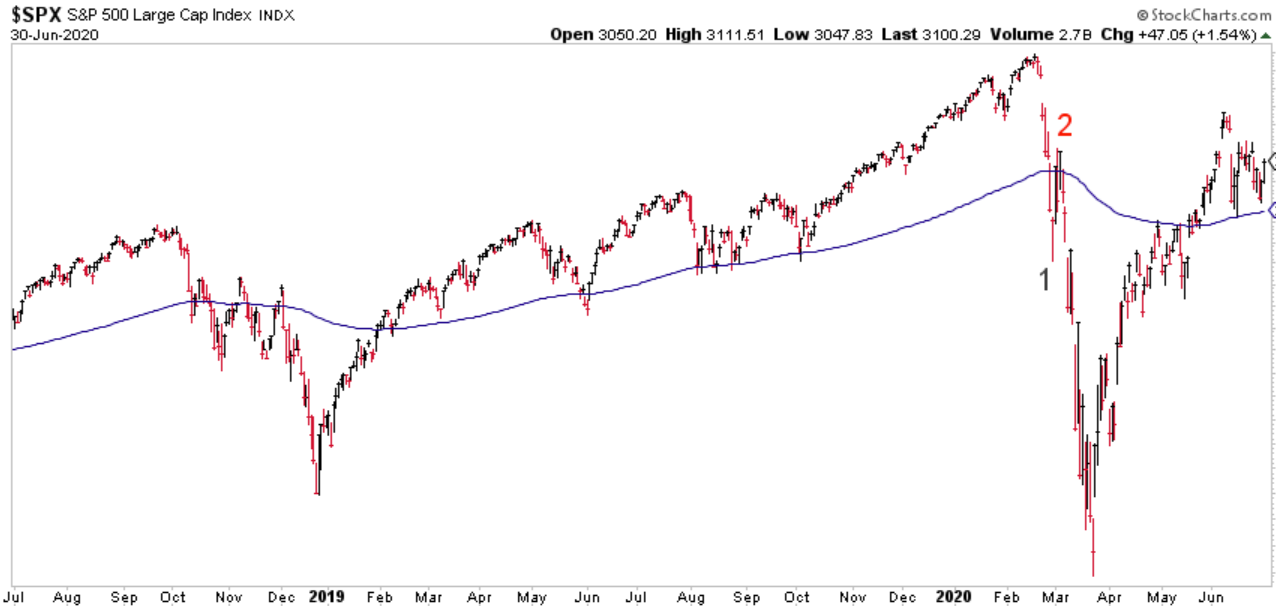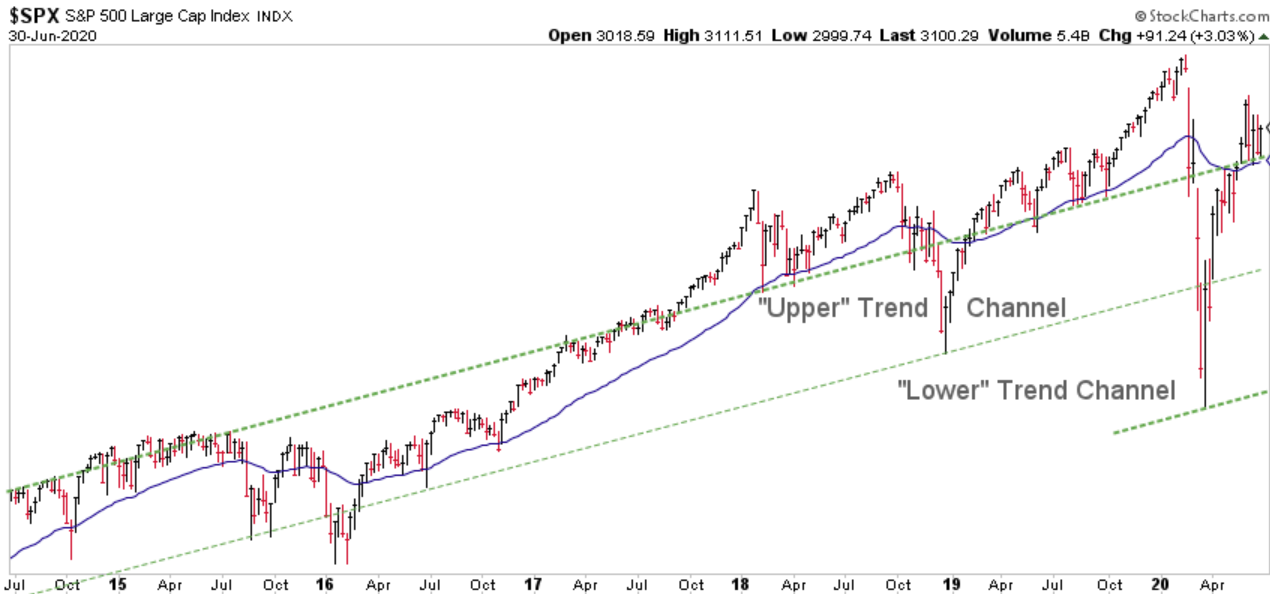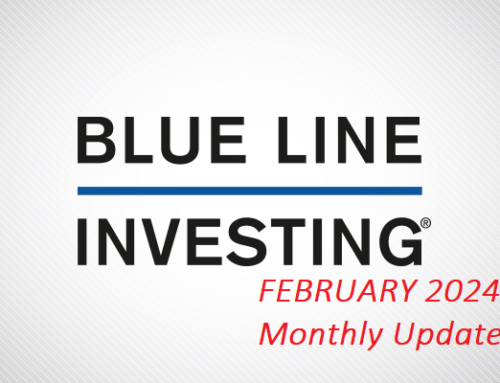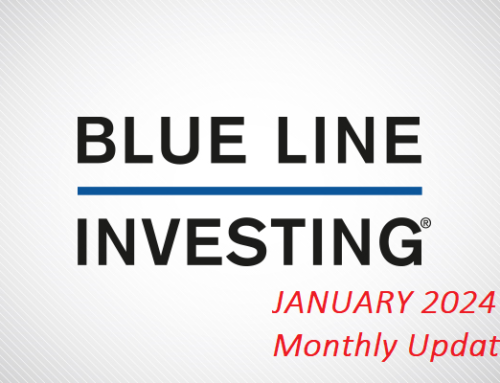The US stock market, as measured by the S&P 500 Index (S&P), finished the month of June 4.2% above the Blue Line, compared to 3.4% at the end of May. The Green and Purple Lines (not shown) are both now beginning to rise above the Blue Line, which I believe is encouraging.
BLUE LINE Perspective

Chart courtesy of StockCharts.com
As a quick reminder, the ideal pattern for what I believe constitutes a sustainable, rising trend is when price rises above and remains above the Green Line; the Green Line above the Purple Line; and the Purple Line above the Blue Line.
Last month I shared some historical statistics regarding the 1930 and 1940 price rallies. As a quick reminder, price rose 6% above the Blue Line on the 1930 price rally and 4% on the 1940 price rally, then declined thereafter. So far price has risen 9% above the Blue Line on this rally in 2020. So, are we out of the woods yet? Not necessarily.
PRIMARY TREND Perspective
Chapter 5 of my book is called The “Faces” of Risk (due out August 26th) and therein I provide three typical examples of the types of price corrections the stock market has experienced over the past 100 years. Based on what I am showing below, I would normally characterize this as a Channel Correction. Based on how I am identifying the trend below, you can see that price rose rapidly late last year to draw investors into the market at higher prices, then dropped precipitously thereafter. Price broke down through the upper trend channel to a “new” lower trend channel. Since then it has experienced a sharp price bounce back above the “upper” trend channel. However, in my opinion there are at least two significant concerns to be mindful of currently.
First, with price having risen to a new high this year and having declined below the price low of last year, this has created what is called an outside reversal to the downside. On an annual basis, this has not happened since 1792! In other words, this is very rare and suggests caution.
Second, at this time, price is converging with the Blue Line and the top of the rising trend channel. Historically speaking, this is where risk tends to increase. If price declines back below the Blue Line, the probabilities increase that it should at least decline down to the middle green-dashed rising line, if not even the lowest green-dashed line over the months ahead.

Chart courtesy of StockCharts.com
While I have not stated so previously, the purpose for providing this primary trend update is to illustrate the process I apply to all investments held within the BLUE LINE INVESTING® strategies. I simply use the S&P 500 Index to illustrate the process in real time.
Thank you for reading the BLUE LINE INVESTING® PRIMARY TREND update, and please do not hesitate to call (833) 258-2583 with questions or if we may be of service.
Also, additional information will be forthcoming on my book in the coming weeks.
Jeff Link
Disclaimers:
BLUE LINE INVESTING® (BLI) is an actively managed investment process that pursues our mission by combining a trend following investment philosophy and a “buy low, sell high” investment strategy. Our mission is to grow our client’s financial wealth over a full market cycle in a risk-managed and tax-efficient way.
We monitor the relationship between price and the Blue Line over time to help identify which stock markets worldwide are experiencing rising, sideways, and declining primary trends. We prefer to invest in those markets experiencing rising or sideways primary trends, while avoiding those markets experiencing declining primary trends. The Blue Line helps us identify these trends, and when changes may be taking place.
The S&P 500 Index is one of the most commonly followed equity indices, and many consider it one of the best representations of the U.S. stock market, and a bellwether for the U.S. economy. It is comprised of 500 large companies having common stock listed on the NYSE or NASDAQ. The volatility (beta) of the account may be greater or less than the index. It is not possible to invest directly in this index.
Technical analysis is a method of evaluating securities by analyzing statistics generated by market activity, such as past prices and volumes. Technical analysis attempts to predict a future stock price or direction based on market trends. The assumption is that the market follows discernible patterns and if these patterns can be identified then a prediction can be made. The risk is that markets may not always follow patterns. There are certain limitations to technical analysis research, such as the calculation results being impacted by changes in security price during periods of market volatility. Technical analysis is one of many indicators that may be used to analyze market data for investing purposes and should not be considered a guaranteed prediction of market activity. The opinions expressed are those of BLI. The opinions referenced are as of the date of publication and are subject to change without notice. BLI reserves the right to modify its current investment strategies based on changing market dynamics or client needs.
Past performance is not indicative of future results. This material is not financial advice or an offer to sell any product. The information contained herein should not be considered a recommendation to purchase or sell any particular security. Forward looking statements cannot be guaranteed.
Guardian Wealth Advisors, LLC (“GWA”) is an investment adviser registered with the U.S. Securities and Exchange Commission. Registration does not imply a certain level of skill or training. More information about GWA’s investment advisory services can be found in its Form ADV Part 2, which is available upon request.
GWA-20-07




